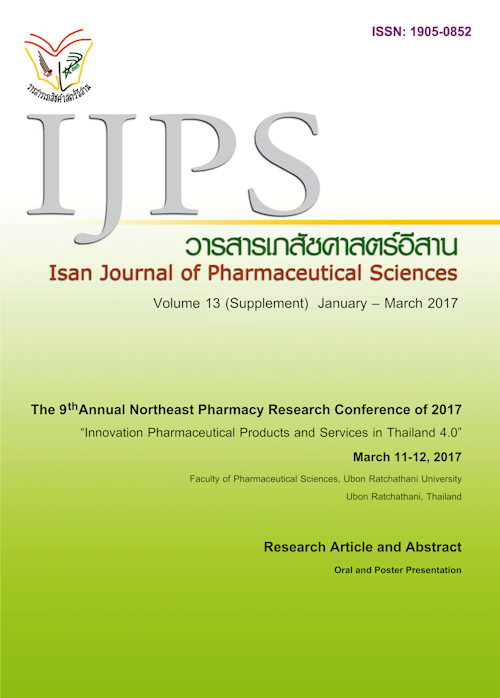Enantioseparation of Phenylglycine by Ligand Exchange Chromatography
Main Article Content
Abstract
Introduction: Since phenylglycine in IDJ configuration is pharmaceutically used for the synthesis of ampicillin and cephalexin, its enantiomeric purity needs to be confirmed prior to use. This study aimed to develop a chiral separation method for phenylglycine instead of using expensive chiral chromatographic columns. It was based on the use of a chiral mobile phase consisting of copper(II) and L-proline with a typical C18 column as a stationary phase. Methods: The optimal conditions for the separation of D- and L-phenylglycine, i.e. the pH of the mobile phase, concentration of copper(II) and L-proline, and percentage of methanol as an organic modifier in the mobile phase, were studied. The performance of the separation was evaluated by the resolution between the peaks of D- and L-isomers as well as the characteristics of the chromatograms. A standard curve was created to investigate the range and linearity. Results: D- and L-phenylglycine best separated from each other with the retention time of about 5 and 11 min, respectively, when a mixture containing 2.5:5 mM copper (II):L-proline, 10% methanol, and with a pH of 6.0 was used as the mobile phase. Under these optimal conditions, satisfactory linear relationships between the concentration and peak area were obtained for both D- and L-phenylglycine with correlation coefficients of 0.9997 and 0.9998 respectively. Conclusion: A copper(II)/L-proline mixture at a suitable concentration and pH in the presence of an appropriate amount of methanol could be effectively used as a mobile phase together with a C18 column for the separation of phenylglycine enantiomers. Thus, these optimal conditions can be used for the further development and validation of a simple and inexpensive method for the quantitation of D- and L-phenylglycine.
Article Details
In the case that some parts are used by others The author must Confirm that obtaining permission to use some of the original authors. And must attach evidence That the permission has been included
References
Davankov VA, Kurganov AA. The role of achiral sorbent matrix in chiral recognition of amino acid enantiomers in ligand-exchange chromatography. Chromatographia. 1983, 17(12): 686-690.
Hu SQ, Lu WJ, Ma YH, Hu Q, Dong LJ, Chen XG. Chiral separation of β-blockers by MEEKC using neutral microemulsion: analysis of separation mechanism and further elucidation of resolution equation. Electrophoresis. 2013, 34(2): 260s268.
Husain S, Sekar R, Ran RN. Enantiomeric separation and determination of antiparkinsonian drugs by reversed-phase ligand-exchange high-performance liquid chromatography. J Chromatogr A. 1994, 687(2): 351-355.
Lam S, Malikin G. Strategy combining chiral chromatography with β-cyclodextrin and stereospecific enzyme reaction detection with hydroxysteroid dehydrogenases for resolving steroid epimers. Chirality. 1992, 4(16): 395-399.
Machelli R, Corradini R, Galaverna G, Dossena A, Dallavalle F and Sforza S. Chiral separatioin techniques. Wiley, New York, 2007, p 301.
Mericko D, Lehotay J, Cizmarik J and Slov C. HPLC separation of enantiomers using chiral stationary phase. Farm. 2007, 56(3): 107-113.
Pirkle WH, Pochapsky TC. Consideration of chiral recognition relevant to the liquid chromatography separation of enantiomers. Chem Rev. 1989, 89(2): 347-362.
Sajewicz M, Gontarska M and Kowalska T. HPLC-DAD evidence of the oscillatory chiral conversion of phenylglycine. J Chromatogr Sci. 2014, 52(4): 329-333.
Sotgia S, Zinellu A, Pisanu E, Pinna GA, Deiana L, Carru C. Enantiomeric reversed-phase high-performance liquid chromatography resolution of D-/L-penicillamine after spirocyclization with ninhydrin and by using copper(II)-L-proline complex as a chiral selector in the mobile phase. J Chromatogr A. 2008, 1205: 90-93.
Victery W, Tyroler HA, Volpe R and Grant LD. Summary of discussion sessions: symposium on lead-blood pressure relationships. Environ Health Perspect. 1988, 78: 139-155.
Wang LJ, Hu SQ, Guo QL, Yang GL, Chen XG. Di-n-amyl L-tartrate-boric acid complex chiral selector in situ synthesis and its application in chiral non-aqueous capillary electrophoresis. J Chromatogr A. 2011, 1218: 1300s1309.
Wang LJ, Yang J, Yang GL, Chen XG. In situ synthesis of twelve dialkyltartrate-boric acid complexes and two polyols-boric acid complexes and their applications as chiral ion-pair selectors in nonaqueous capillary electrophoresis. J Chromatogr A. 2012, 1248: 182s187.
Wu Y, Zhai Y, Zhang Y, Zhang H, Jing H, Chen A. Chiral separation and determination of amino acids in real samples by LE-MEKC using Cu(II)-L-proline as chiral selector. J Chromatogr B. 2014, 965: 254-259.
Yamazaki S, Saito Katsunori, Tanimura T. Enantiomeric separation of underivatized aliphatic β-amino alcohols by ligand-exchange chromatography using N-n-dodecyl-(1R,2S)-norephedrine as a coating reagent for reversed-phase column. J Sep Sci. 1994, 21(10): 561-564.
Zukowski J, Pawlowska M, Pietraszkiewicz M. Enantioseparation of α-phenylglycine by HPLC on an ODS column coated with chiral crown ether. Chromatographia. 1991, 32(1): 82-84.


